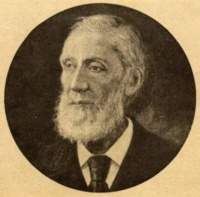Cirilo Villaverde facts for kids
Quick facts for kids
Cirilo Villaverde
|
|
|---|---|
 |
|
| Born | 28 October 1812 near Pinar del Río, Cuba |
| Died | 24 October 1894 New York |
Cirilo Villaverde de la Paz (1812 - 1894) was a Cuban writer and a fighter for freedom. He wrote poems, novels, and worked as a journalist. He is most famous for his novel Cecilia Valdés. This book tells a story about different social classes and races in Cuba when it was a Spanish colony.
Contents
Life Story
Early Life and Education
Cirilo Villaverde was born in 1812 on a sugar plantation near Pinar del Río, Cuba. His father was a doctor. Living near a sugarcane mill, Cirilo saw the harsh realities of slavery from a young age.
In 1820, his family moved to Havana. There, he studied law. However, he only worked briefly as a lawyer. Soon, he decided to become a teacher and focus on writing.
Becoming a Writer and Freedom Fighter
Cirilo's first writings appeared in a magazine called Miscelánea, de útil y agradable recreo. He also joined literary groups led by Domingo del Monte. Domingo del Monte believed in good public education. During this time, Cirilo wrote for many different magazines.
Around 1840, Cirilo started to support Cuba becoming independent from Spain. He worked as a secretary for General Narciso López. López later tried to free Cuba from Spanish rule, but his attempts were not successful.
Exile and Return
In 1848, Spanish soldiers arrested Villaverde at his home. But the next year, he managed to escape. He fled to the United States and settled in New York City. There, he continued his political work. He edited and published magazines for Cubans living in exile, like La Verdad and El Independiente.
In 1858, he returned to Cuba under a general pardon. He edited and wrote for several magazines there. However, he seemed disappointed with the situation in Cuba. So, in 1860, he went back to New York. He worked as an editor for Frank Leslie's Illustrated Newspaper.
In 1864, Cirilo and his wife opened a private school in Weehawken. Four years later, a war for independence, known as the Ten Years' War, began in Cuba. Cirilo joined a group of revolutionaries living outside Cuba.
Later Years and Legacy
For the rest of his life, Cirilo Villaverde continued to write novels, translate texts, and work for Cuban independence. He visited Cuba briefly in 1888 and again in 1894, just before he passed away. He died in New York, but his body was returned to Cuba. He was buried in an unmarked grave.
In 2008, a Cuban writer named Daína Chaviano honored Cirilo Villaverde in her novel The Island of Eternal Love. Cirilo appears as a character in her book. Chaviano also tells a different version of Cecilia Valdés within her story.
Main Works
Cirilo Villaverde wrote many important pieces. Here are some of his well-known works:
- "The Girl with the Golden Arrow" (La joven de la flecha del oro)
- "The Farmer" (El Guajiro)
- "The Cuban Revolution Seen From New York" ("La revolucion de Cuba vista desde New York")
- "Cecilia Valdés or the Hill of the Angel" (Cecilia Valdés o La Loma del Angel)
This novel was the most important work of his life. Many people consider it one of the most significant Cuban novels of the 19th century. You can read the full book online at Project Gutenberg.
See also
 In Spanish: Cirilo Villaverde para niños
In Spanish: Cirilo Villaverde para niños

